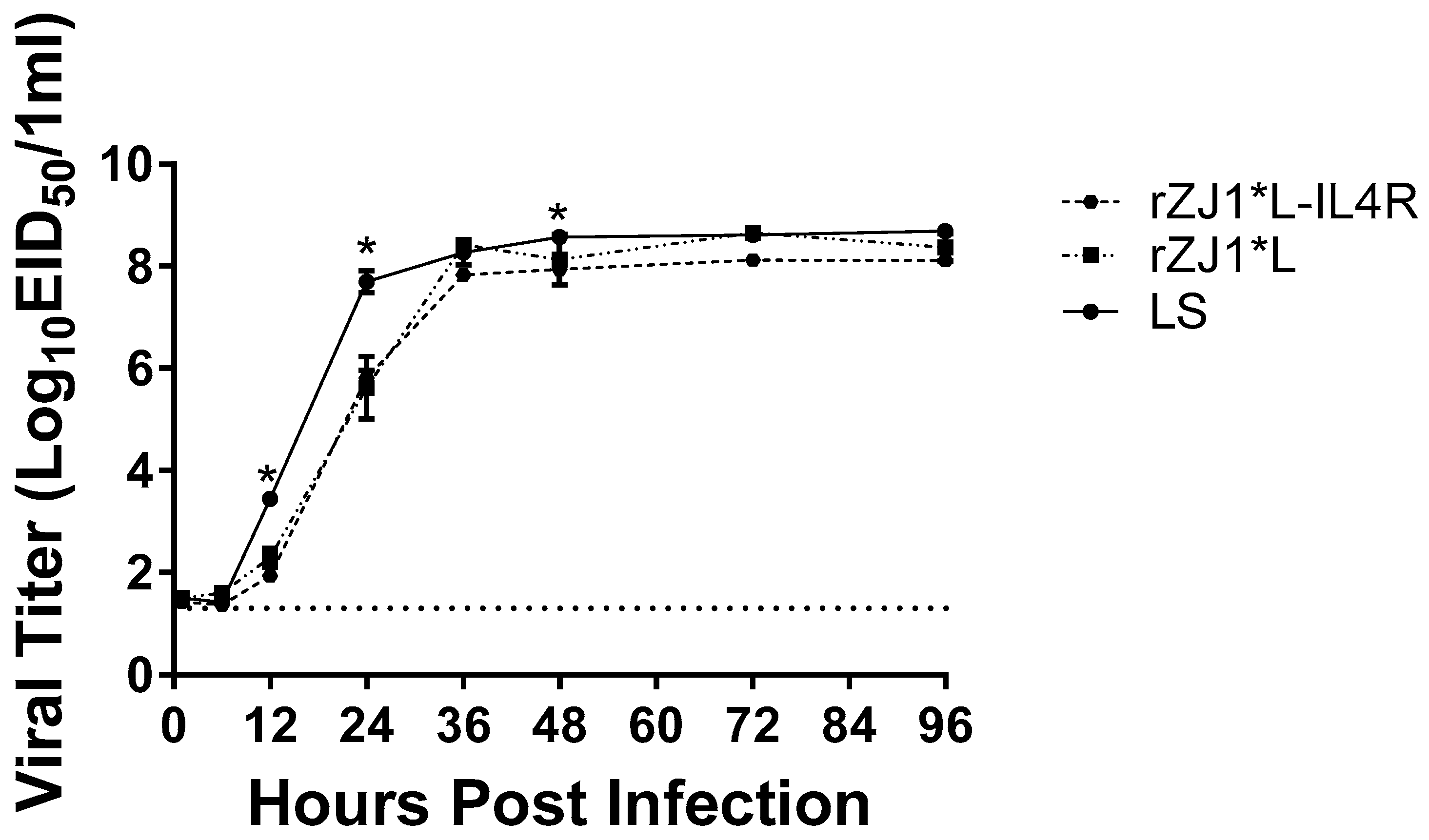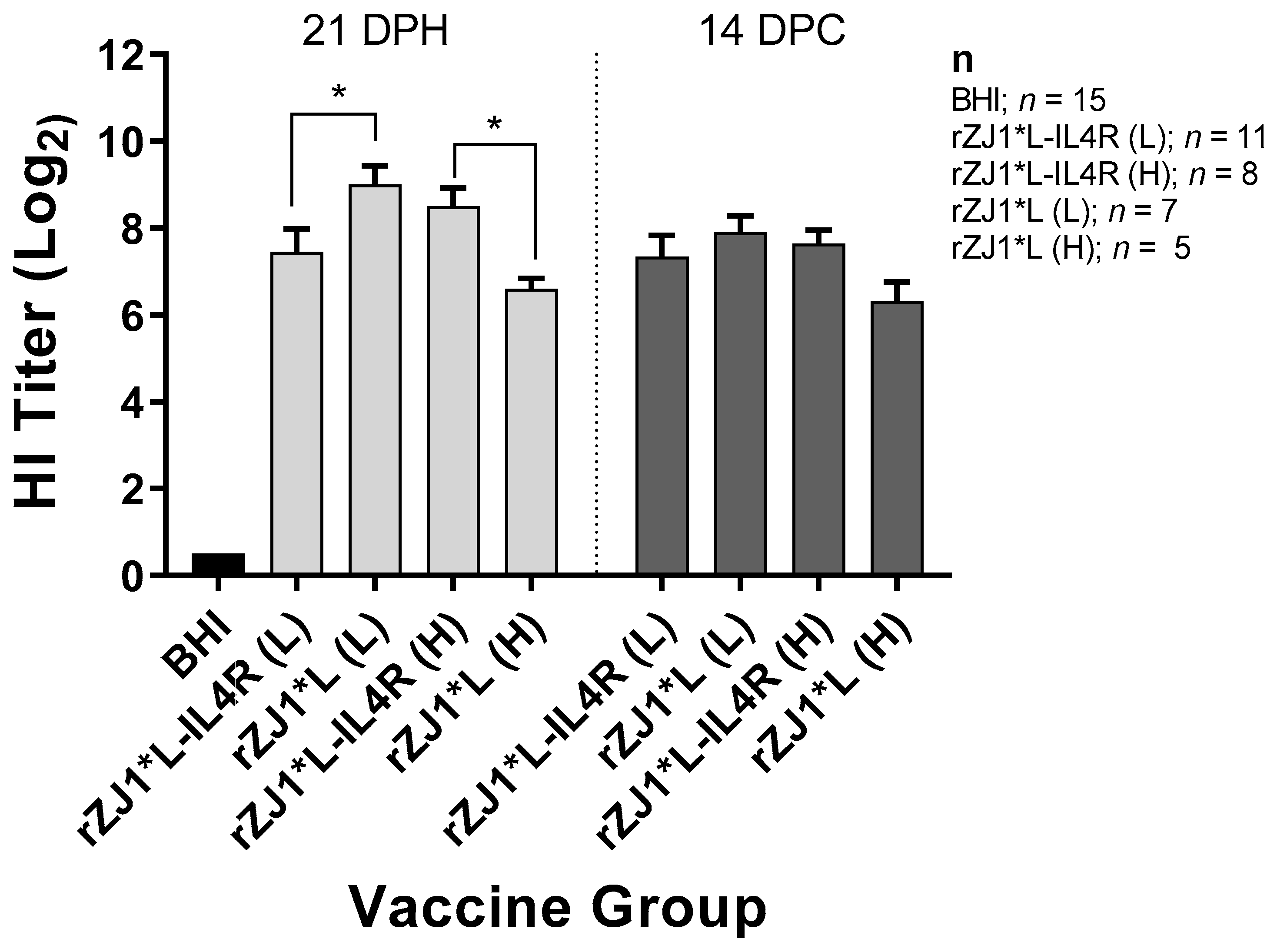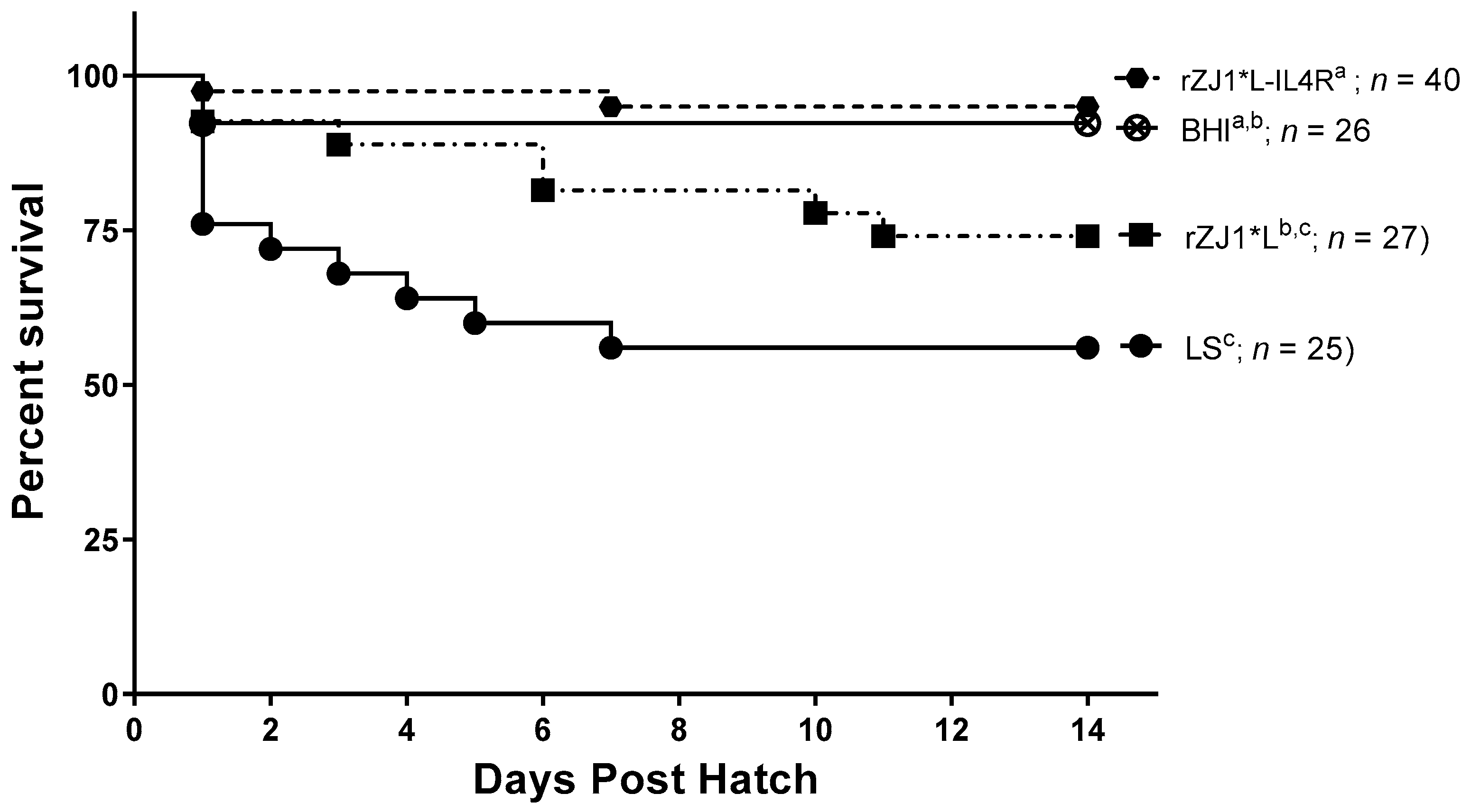A Novel Recombinant Newcastle Disease Vaccine Improves Post- In Ovo Vaccination Survival with Sustained Protection against Virulent Challenge
Abstract
:1. Introduction
2. Materials and Methods
2.1. Embryonated Chicken Eggs (ECEs)
2.2. Viruses
2.3. Cells
2.4. Cloning
2.5. Construction of Recombinant cDNA Full-Length Clone rZJ1*L-IL4R
2.6. Virus Rescue
2.7. Intracerebral Pathogenicity Index (ICPI) Assay
2.8. Mean Death Time (MDT)
2.9. Virus Growth Kinetics in SPF ECEs
2.10. Vaccination at 18 Days of Embryonation (DOE) with 103.5 or 104.5 EID50/egg of Various NDV Vaccines
2.11. Vaccination at 19 DOE with 103.5 of Various NDV Vaccines
2.12. Isolation and Quantification of Viral RNA
2.13. Statistical Analyses
2.14. Animal Use and Care
3. Results
3.1. Mean Death Time, Intracerebral Pathogenicity Index, and Growth Characteristics of Viral Strains
3.2. Effect of rZJ1*L-IL4R Vaccination at 18 DOE on Post-Hatch Survival
3.3. Effect of rZJ1*L-IL4R Vaccination at 18 DOE and Virulent NDV Challenge at 21 DPH on HI Titers
3.4. Effect of rZJ1*L-IL4R Vaccination at 18 DOE on Post-Challenge Viral Shedding and Survival
3.5. Effect of rZJ1*L-IL4R Vaccination at 19 DOE on Survival
3.6. Effect of rZJ1*L-IL4R Vaccination at 19 DOE on Vaccine Shedding at 3 DPH
3.7. Effect of rZJ1*L-IL4R Vaccination at 19 DOE on Pre- and Post-Challenge HI Titers
3.8. Effect of rZJ1*L-IL4R Vaccination at 19 DOE on Post-Challenge Viral Shedding
4. Discussion
Author Contributions
Funding
Institutional Review Board Statement
Acknowledgments
Conflicts of Interest
References
- Amarasinghe, G.K.; Ceballos, N.G.A.; Banyard, A.C.; Basler, C.F.; Bavari, S.; Bennett, A.J.; Blasdell, K.R.; Briese, T.; Bukreyev, A.; Caì, Y.; et al. Taxonomy of the order Mononegavirales: Update 2018. Arch. Virol. 2018, 163, 2283–2294. [Google Scholar] [CrossRef] [Green Version]
- Miller, P.J.; Koch, G. Newcastle Disease, Avian Paramyxoviruses and Avian Metapneumovirus in Diseases of Poultry; Swayne, D.E., Boulianne, M., Logue, C.M., McDougald, L.R., Nair, V., Suarez, D.L., Sjaak de Wit, S., Grimes, T., Johnson, D., Kromm, M., et al., Eds.; Wiley-Blackwell: Ames, IA, USA, 2013. [Google Scholar]
- Miller, P.J.; Decanini, E.L.; Afonso, C.L. Newcastle disease: Evolution of genotypes and the related diagnostic challenges. Infect. Genet. Evol. 2010, 10, 26–35. [Google Scholar] [CrossRef]
- Miller, P.J.; Haddas, R.; Simanov, L.; Lublin, A.; Rehmani, S.F.; Wajid, A.; Bibi, T.; Khan, T.A.; Yaqub, T.; Setiyaningsih, S.; et al. Identification of new sub-genotypes of virulent Newcastle disease virus with potential panzootic features. Infect. Genet. Evol. 2015, 29, 216–229. [Google Scholar] [CrossRef] [PubMed]
- Nath, B.; Barman, N.; Kumar, S. Molecular characterization of Newcastle disease virus strains isolated from different outbreaks in Northeast India during 2014–2015. Microb. Pathog. 2016, 91, 85–91. [Google Scholar] [CrossRef] [PubMed]
- Sun, M.; Dong, J.; Wang, Z.; Li, L.; Yuan, J.; Jiano, P.; Hu, Q.; Ren, T. Complete genome sequence of a newly emerging Newcastle disease virus isolated in china. Genome Announc. 2013, 1, 41. [Google Scholar] [CrossRef] [PubMed] [Green Version]
- Shabbir, M.Z.; Zohari, S.; Yaqub, T.; Nazir, J.; Shabbir, M.A.B.; Mukhtar, N.; Shafee, M.; Sajid, M.; Anees, M.; Abba, M.; et al. Genetic diversity of Newcastle disease virus in Pakistan: A countrywide perspective. Virol. J. 2013, 10, 1–10. [Google Scholar] [CrossRef] [Green Version]
- Kammon, A.; Heidari, A.; Dayhum, A.; Eldaghayes, I.; Sharif, M.; Monne, I.; Cattoli, G.; Asheg, B.; Farhat, M.; Kraim, E. Characterization of Avian Influenza and Newcastle Disease Viruses from Poultry in Libya. Avian Dis. 2015, 59, 422–430. [Google Scholar] [CrossRef]
- Perozo, F.; Marcano, R.; Afonso, C. Biological and phylogenetic characterization of a genotype VII Newcastle disease virus from Venezuela: Efficacy of field vaccination. J. Clin. Microbiol. 2012, 50, 1204–1208. [Google Scholar] [CrossRef] [Green Version]
- Jaganathan, S.; Ooi, P.T.; Phang, L.Y.; Allaudin, Z.N.B.; Yip, L.S.; Choo, P.Y.; Lim, B.K.; Lemiere, S.; Audonnet, J.-C. Observation of risk factors, clinical manifestations and genetic characterization of recent Newcastle Disease Virus outbreak in West Malaysia. BMC Vet. Res. 2015, 11, 219. [Google Scholar] [CrossRef] [Green Version]
- Absalon, A.E.; Cortés-Espinosa, D.V.; Lucio, E.; Miller, P.J.; Afonso, C.L. Epidemiology, control, and prevention of Newcastle disease in endemic regions: Latin America. Trop. Anim. Health Prod. 2019, 51, 1033–1048. [Google Scholar] [CrossRef] [Green Version]
- Wajid, A.; Dimitrov, K.M.; Wasim, M.; Rehmani, S.F.; Basharat, A.; Bibi, T.; Arif, S.; Yaqub, T.; Tayyab, M.; Ababneh, M.; et al. Repeated isolation of virulent Newcastle disease viruses in poultry and captive non-poultry avian species in Pakistan from 2011 to 2016. Prev. Vet. Med. 2017, 142, 1–6. [Google Scholar] [CrossRef]
- Dimitrov, K.M.; Afonso, C.L.; Yu, Q.; Miller, P.L. Newcastle disease vaccines-A solved problem or a continuous challenge? Vet. Microbiol. 2017, 206, 126–136. [Google Scholar] [CrossRef]
- Marangon, S.; Busani, L. The use of vaccination in poultry production. Rev. Sci. Tech. Int. Off. Epizoot. 2007, 26, 265–274. [Google Scholar] [CrossRef] [Green Version]
- Schijns, V.E.J.C.; van de Zande, S.; Lupiani, B.; Reffy, S.M. Practical Aspects of Poultry Vaccination. In Avian Immunology; Schat, K.A., Kaspers, B., Kaiser, P., Eds.; Elsevier: Amsterdam, The Netherlands, 2013; pp. 345–362. [Google Scholar]
- Gallili, G.E.; Ben-Nathan, D. Newcastle disease vaccines. Biotechnol. Adv. 1998, 16, 343–366. [Google Scholar] [CrossRef]
- Jansen, T.; Hofmans, M.P.M.; Theelen, M.J.G.; Cshijns, V.E.J.C. Structure-activity relations of water-in-oil vaccine formulations and induced antigen-specific antibody responses. Vaccine 2005, 23, 1053–1060. [Google Scholar] [CrossRef]
- Sharma, J.M.; Burmester, B.R. Resistance of Marek’s Disease at Hatching in Chickens Vaccinated as Embryos with the Turkey Herpesvirus. Avian Dis. 1982, 26, 134–149. [Google Scholar] [CrossRef] [PubMed]
- Sharma, J.M. Embryo Vaccination with Infectious Bursal Disease Virus Alone or in Combination with Marek’s Disease Vaccine. Avian Dis. 1985, 29, 1155–1169. [Google Scholar] [CrossRef]
- Sarma, G.; Greer, W.; Gildersleeve, R.P.; Murray, D.L.; Miles, A.M. Field Safety and Efficacy of in ovo Administration of HVT + SB-1 Bivalent Marek’s Disease Vaccine in Commercial Broilers. Avian Dis. 1995, 39, 211–217. [Google Scholar] [CrossRef]
- Okwor, G.O.; El-Yuguda, A.; Baba, S.S. Profile of Maternally Derived Antibody in Broiler Chicks and In-Ovo Vaccination of Chick Embryo against Newcastle Disease. World J. Vaccines 2014, 04, 72–80. [Google Scholar] [CrossRef] [Green Version]
- Dilaveris, D.; Chen, C.; Kaiser, P.; Russel, P.H. The safety and immunogenicity of an in ovo vaccine against Newcastle disease virus differ between two lines of chicken. Vaccine 2007, 25, 3792–3799. [Google Scholar] [CrossRef]
- Mast, J.; Nanbru, C.; Decaesstecker, M.; Lambrecht, B.; Couvreur, B.; Meulemans, G.; van den Berg, T. Vaccination of chicken embryos with escape mutants of La Sota Newcastle disease virus induces a protective immune response. Vaccine 2006, 24, 1756–1765. [Google Scholar] [CrossRef]
- Cardenas-Garcia, S.; Dunwoody, R.P.; Marcano, V.; Diel, D.G.; Williams, R.J.; Gogal, R.M., Jr.; Brown, C.C.; Miller, P.J.; Afonso, C.L. Effects of Chicken Interferon Gamma on Newcastle Disease Virus Vaccine Immunogenicity. PLoS ONE 2016, 11, e0159153. [Google Scholar] [CrossRef] [PubMed]
- Kapczynski, D.R.; Martin, A.; Haddad, E.E.; King, D.J. Protection from clinical disease against three highly virulent strains of Newcastle disease virus after in ovo application of an antibody-antigen complex vaccine in maternal antibody-positive chickens. Avian Dis. 2012, 56, 555–560. [Google Scholar] [CrossRef] [PubMed]
- Palya, V.; Kiss, I.; Tatár-Kis, T.; Mató, t.; Felföldi, B.; Gardin, Y. Advancement in vaccination against Newcastle disease: Recombinant HVT NDV provides high clinical protection and reduces challenge virus shedding with the absence of vaccine reactions. Avian Dis. 2012, 56, 282–287. [Google Scholar] [CrossRef]
- Esaki, M.; Godoy, A.; Rosenberger, J.K.; Rosenberger, S.C.; Gardin, Y.; Yasuda, A.; Dorsey, K.M. Protection and antibody response caused by turkey herpesvirus vector Newcastle disease vaccine. Avian Dis. 2013, 57, 750–755. [Google Scholar] [CrossRef] [PubMed]
- Schat, K.A. Back to the Past: Do Vector Vaccines Represent the Future? Department of Microbiology and Immunology College of Veterinary Medicine, Cornell University: Ithaca, NY, USA, 2015; pp. 1–12. [Google Scholar]
- Liu, Y.L.; Hu, S.L.; Zhang, Y.M.; Sun, S.J.; Romer-Oberdorfer, A.; Veits, J.; Wu, Y.T.; Wan, H.Q.; Liu, X.F. Generation of a velogenic Newcastle disease virus from cDNA and expression of the green fluorescent protein. Arch. Virol. 2007, 152, 1241–1249. [Google Scholar] [CrossRef]
- Cornax, I.; Miller, P.J.; Afonso, C.L. Characterization of Live LaSota Vaccine Strain–Induced Protection in Chickens upon Early Challenge with a Virulent Newcastle Disease Virus of Heterologous Genotype. Avian Dis. 2012, 56, 464–470. [Google Scholar] [CrossRef]
- Afonso, C.L.; Marcano, V.C.; Garcia, N.S.C.; Yu, Q.; Taylor, T.L. Altered Avian Virus for in-ovo Inoculation and Methods of use Thereof. U.S. Patent 10,196,616, 2019. [Google Scholar]
- Susta, L.; Cornax, I.; Diel, D.G.; Garcia, S.C.; Miller, P.J.; Liu, X.; Hu, S.; Brown, C.C.; Afonso, C.L. Expression of interferon gamma by a highly virulent strain of Newcastle disease virus decreases its pathogenicity in chickens. Microb. Pathog. 2013, 61–62, 73–83. [Google Scholar] [CrossRef]
- Cardenas-Garcia, S.; Diel, D.G.; Susta, L.; Lucio, E. Development of an improved vaccine evaluation protocol to compare the efficacy of Newcastle disease vaccines. Biologicals 2015, 43, 136–145. [Google Scholar] [CrossRef]
- Domenech, J.; Vallat, B.; Cupua, I. Newcastle Disease in Manual of Diagnostic Tests and Vaccines for Terrestrial Animals; Capua, I., Alexander, D.J., Eds.; Springer: Berlin/Heidelberg, Germany, 1988. [Google Scholar]
- Alexander, D.J.; Senne, D.A. Newcastle Disease and other Paramyxoviruses. In A Laboratory Manual for the Isolation Identification and Characterization of Avian Pathogens; Swayne, G.J.R., Pearson, D.E., Reed, J.E., Jackwood, W.M., Woolcock, W.M., Dufour-Zavala, P.R., Eds.; OmniPress, Inc.: Norristown, PA, USA, 2008; pp. 135–141. [Google Scholar]
- Li, J.; Hu, H.; Yu, Q.; Diel, D.G.; Li, D.-S.; Miller, P.J. Generation and characterization of a recombinant Newcastle disease virus expressing the red fluorescent protein for use in co-infection studies. Virol. J. 2012, 9, 227. [Google Scholar] [CrossRef] [Green Version]
- Karber, G. 50% end-point calculation. Arch. Exp. Pathol. Pharmak. 1931, 162, 480–483. [Google Scholar]
- Wise, M.G.; Suarez, D.L.; Seal, B.S.; Pedersen, J.C.; Senne, D.A.; King, D.J.; Kapczynski, D.R.; Spackman, E. Development of a Real-Time Reverse-Transcription PCR for Detection of Newcastle Disease Virus RNA in Clinical Samples. J. Clin. Microbiol. 2004, 42, 329–338. [Google Scholar] [CrossRef] [Green Version]
- Giambrone, J.J.; Closser, J. Effect of breeder vaccination on immunization of progeny against Newcastle disease. Avian Dis. 1990, 34, 114–119. [Google Scholar] [CrossRef] [PubMed]
- Siegrist, C. Mechanisms by which maternal antibodies influence infant vaccine responses: Review of hypotheses and definition of main determinants. Vaccine 2003, 21, 3406–3412. [Google Scholar] [CrossRef]
- Karlsson, M.C.I.; Getahun, A.; Heyman, B. Fc RIIB in IgG-Mediated Suppression of Antibody Responses: Different Impact In Vivo and In Vitro. J. Immunol. 2001, 167, 5558–5564. [Google Scholar] [CrossRef] [PubMed]
- Karlsson, M.C.I.; Wernersson, S.; de Ståhl, T.D.; Gustavsson, S.; Heyman, B. Efficient IgG-mediated suppression of primary antibody responses in Fcg receptor-deficient mice. Proc. Natl. Acad. Sci. USA 1999, 96, 2244–2249. [Google Scholar] [CrossRef] [PubMed] [Green Version]
- Heyman, B. Regulation of antibody responses via antibodies, complement, and fc receptors. Annu. Rev. Immunol. 2000, 18, 709–737. [Google Scholar] [CrossRef] [PubMed]
- D’Ambrosio, D.; Hippenst, K.L.; Minskoff, S.A.; Mellman, I.; Pani, G.; Siminovitch, K.A.; Cambier, J.C. Recruitment and Activation of PTP1 C in Negative Regulation of Antigen Receptor Signaling by FcyRIIB1. Science 1995, 268, 293–297. [Google Scholar] [CrossRef]
- Chan, P.L.; Sinclair, N.R.S. Regulation of the Immune Response VI. Inability of F(ab’) 2 antibody to terminate established immune responses and its ability to interfere with IgG antibody-mediated immunosuppression. Immunology 1973, 24, 289–301. [Google Scholar]
- Ganar, K.; Das, M.; Sinha, S.; Kumar, S. Newcastle disease virus: Current status and our understanding. Virus Res. 2014, 184, 71–81. [Google Scholar] [CrossRef]
- Taylor, T.L.; Miller, P.J.; Olivier, T.L.; Montiel, E.; Cardenas-Garcia, S.; Dimitrov, K.M.; Williams-Coplin, D.; Afonso, C.L. Repeated Challenge with Virulent Newcastle Disease Virus Does not Decrease the Efficacy of Vaccines. Avian Dis. 2017, in press. [Google Scholar] [CrossRef] [PubMed]
- Dortmans, J.C.F.M. Newcastle disease virus outbreaks: Vaccine mismatch or inadequate application? Vet. Microbiol. 2012, 160, 17–22. [Google Scholar] [CrossRef] [PubMed]
- Dunon, D.; Courtois, D.; Vainio, O.; Six, A.; Chen, C.H.; Cooper, M.D.; Dangy, J.P.; Imhof, B.A. Ontogeny of the immune system: Gamma/delta and alpha/beta T cells migrate from thymus to the periphery in alternating waves. J. Exp. Med. 1997, 186, 977–988. [Google Scholar] [CrossRef] [PubMed] [Green Version]
- Coltey, M.; Jotereau, F.V.; Le Douarin, N.M. Evidence for a cyclic renewal of lymphocyte precursor cells in the embryonic chick thymus. Cell Differ. 1987, 22, 71–82. [Google Scholar] [CrossRef]
- Pelechano, V.; Steinmetz, L.M. Gene regulation by antisense transcription. Nat. Rev. Genet. 2013, 14, 880–893. [Google Scholar] [CrossRef]
- Cheng, J.Q.; Ruggeri, B.; Klein, W.M.; Sonoda, G.; Altomare, D.A.; Watson, D.K.; Testa, J.R. Amplification ofAKT2 in human pancreatic cancer cells and inhibition ofAKT2 expression and tumorigenicity by antisense RNA. Proc. Natl. Acad. Sci. USA 1996, 93, 3636–3641. [Google Scholar] [CrossRef] [Green Version]
- Yu, W.; Gius, D.; Onyango, P.; Muldoon-Jacobs, K.; Karp, J.; Feinberg, A.P.; Cui, H. Epigenetic silencing of tumour suppressor gene p15 by its antisense RNA. Nature 2008, 451, 202–206. [Google Scholar] [CrossRef]
- Xu, Z.; Wei, W.; Gagneur, J.; Clauder-Münster, S.; Smolik, M.; Huber, W.; Steinmetz, L.M. Antisense expression increases gene expression variability and locus interdependency. Mol. Syst. Biol. 2011, 7, 468. [Google Scholar] [CrossRef]
- Liu, Y.; Wang, Q.; Kleinschmidt-DeMasters, B.K.; Franzusoff, A.; Ng, K.-Y.; Lillehei, K.O. TGF-beta2 inhibition augments the effect of tumor vaccine and improves the survival of animals with pre-established brain tumors. J. Neurooncol. 2007, 81, 149–162. [Google Scholar] [CrossRef]
- Nemunaitis, J.; Dillman, R.O.; Schwarzenberger, P.O.; Senzer, N.; Cunningham, C.; Cutler, J.; Tong, A.; Kumar, P.; Pappen, B.; Hamilton, C.; et al. Phase II study of belagenpumatucel-L, a transforming growth factor beta-2 antisense gene-modified allogeneic tumor cell vaccine in non-small-cell lung cancer. J. Clin. Oncol. 2006, 24, 4721–4730. [Google Scholar] [CrossRef]
- Yang, B. A novel bi-functional DNA vaccine expressing VP1 protein and producing antisense RNA targeted to 5′UTR of foot-and-mouth disease virus can induce both rapid inhibitory effect and specific immune response in mice. Vaccine 2008, 26, 5477–5483. [Google Scholar] [CrossRef]








| NDV Vaccine Strain | MDT b | ICPI c |
|---|---|---|
| vZJ1 a | 54.5 | 1.83 |
| rZJ1*L-IL4R | >168 | 0.25 |
| rZJ1*L | >168 | 0.35 |
| LS | 110–153.25 | 0.15–0.30 |
| Vaccine Group | Chickens Challenged | Survival (%) |
|---|---|---|
| BHI | 15 | 0 a |
| rZJ1*L-IL4R 103.5 | 11 | 100 b |
| rZJ1*L 103.5 | 7 | 100 b |
| rZJ1*L-IL4R 104.5 | 8 | 100 b |
| rZJ1*L 104.5 | 5 | 100 b |
Publisher’s Note: MDPI stays neutral with regard to jurisdictional claims in published maps and institutional affiliations. |
© 2021 by the authors. Licensee MDPI, Basel, Switzerland. This article is an open access article distributed under the terms and conditions of the Creative Commons Attribution (CC BY) license (https://creativecommons.org/licenses/by/4.0/).
Share and Cite
Marcano, V.C.; Cardenas-Garcia, S.; Diel, D.G.; Antoniassi da Silva, L.H.; Gogal, R.M., Jr.; Miller, P.J.; Brown, C.C.; Butt, S.L.; Goraichuk, I.V.; Dimitrov, K.M.; et al. A Novel Recombinant Newcastle Disease Vaccine Improves Post- In Ovo Vaccination Survival with Sustained Protection against Virulent Challenge. Vaccines 2021, 9, 953. https://doi.org/10.3390/vaccines9090953
Marcano VC, Cardenas-Garcia S, Diel DG, Antoniassi da Silva LH, Gogal RM Jr., Miller PJ, Brown CC, Butt SL, Goraichuk IV, Dimitrov KM, et al. A Novel Recombinant Newcastle Disease Vaccine Improves Post- In Ovo Vaccination Survival with Sustained Protection against Virulent Challenge. Vaccines. 2021; 9(9):953. https://doi.org/10.3390/vaccines9090953
Chicago/Turabian StyleMarcano, Valerie C., Stivalis Cardenas-Garcia, Diego G. Diel, Luciana H. Antoniassi da Silva, Robert M. Gogal, Jr., Patti J. Miller, Corrie C. Brown, Salman Latif Butt, Iryna V. Goraichuk, Kiril M. Dimitrov, and et al. 2021. "A Novel Recombinant Newcastle Disease Vaccine Improves Post- In Ovo Vaccination Survival with Sustained Protection against Virulent Challenge" Vaccines 9, no. 9: 953. https://doi.org/10.3390/vaccines9090953







